Can reptiles like bearded dragons make good emotional support animals?
In this guide, you’ll learn:
- What is an Emotional Support Animal?
- Reasons why reptiles are goode ESAs
- Reasons reptiles may not be good ESAs
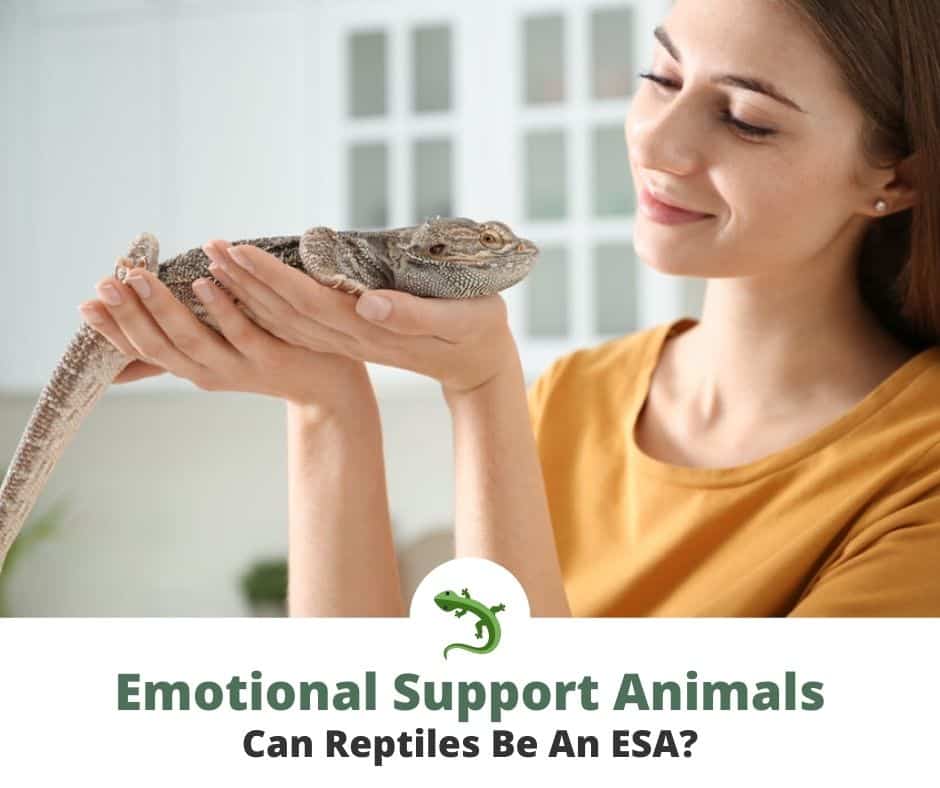
Yes, reptiles make good emotional support animals. Though not exactly fluffy and cuddly, they do spark curiosity allowing people who are reserved to become more relaxed. They help people have a sense of purpose because they need to be taken care of but are low maintenance enough for people who can’t give that much attention to a full-time pet.
A velociraptor is definitely not what one would have in mind when you think ESA or service animal. To some, reptiles may not be what they had in mind either, but these unique creatures can definitely be emotional support animals and are often effective ones.
Animals have long been used as support in therapy sessions. In the 1930s, Sigmund Freud began noticing a positive effect on himself and his patients during the sessions wherein he had his dog with him. Though still lacking strong scientific research and data, a lot of mental health professionals today recognize the increased effectiveness of including emotional support animals in their treatments.
What Exactly is an Emotional Support Animal (ESA)?
An emotional support animal (ESA) is an animal companion or a pet that benefits an individual with some form of disability or mental health condition. An ESA is usually prescribed by a licensed psychologist, psychiatrist, or therapist and is an important part of the patient’s treatment.
Animals provide a lot of comfort and unconditional love without judgement which helps ease the anxiety and other negative symptoms associated with an individual’s emotional disorder.
The presence of pets or other animals is often calming and they become a source of emotional support for people who suffer from post-traumatic stress disorder, eating disorders, panic attacks, anxiety, and depression.
Dogs and cats are the most common type of ESAs but most animals that can be domesticated and are manageable in public can be registered as an ESA – including reptiles!
Can Reptiles be Emotional Support Animals?
Yes, reptiles or lizards can definitely be emotional support animals. The National Service Animal Registry states that nearly all domesticated pets qualify as emotional support animals with no additional training required to qualify. Again, the only requirement for your pet to be an ESA is that it must be manageable in public, domesticated, and will not be problematic in a home setting. Some non-traditional ESAs include pigs, horses, and even chickens!
How Are ESAs Different From Therapy Animals?
Therapy animals are trained to provide attention, comfort, and affection to people in need such as those in hospice, retirement homes, nursing homes, and schools.
Pro-tip
Service animals, on the other hand, are trained for a specific task (e.g. detect allergens, guide the blind).
Usually, the presence of an individual’s emotional support animal alone is enough to ease the negative symptoms of their psychological or emotional disorder, such as anxiety, especially in crowded areas like airports. ESAs provide calming and therapeutic benefits through companionship.
How Do ESAs Help Someone?
Emotional support animals help people in many different ways from providing simple comfort through companionship to a sense of purpose through the responsibility of caring for a pet.
Many therapists consider ESAs effective therapy because of the constant support they can provide, compared with a therapy session that is usually only an hour long.
Animals used in therapy sessions often help patients relax by helping ease anxiety and discomfort. They allow patients to open up slowly and at their own pace through simple petting or feeding sessions. In depression patients, for example, the responsibility of taking care of an animal gives a sense of motivation in the simple act of getting up to feed your pet.
An undeniable factor in making animals excellent emotional support for those with disabilities is the companionship and affection these creatures unconditionally provide their owners without any hesitancy, judgment, or complication.
5 Reasons Why Reptiles Make Great ESAs
- Reptiles are often smaller and can be more manageable
Most reptiles are smaller than your traditional emotional support animals (dogs or cats) and can therefore be more manageable especially when you have a small space. Their relatively smaller size also becomes an advantage when you need to take them with you elsewhere. They may also be allowed in more housing apartments or living spaces compared with big pets such as dogs and cats.
- Reptiles require less attention
Reptiles often require less attention but not necessarily less care because reptiles can still be demanding pets. Detailed husbandry is often required for the proper care of certain reptiles. However, compared to a dog or cat, you can usually leave a reptile on its own. They also don’t require exercise or grooming. Some reptiles don’t even need to eat every day!
- Reptiles are unique
Reptiles are definitely unique which leads to special bonds with humans. There are different types of reptiles that can serve as ESAs according to one’s needs. In therapy, the unique aspect of reptiles often sparks the curiosity of more patients allowing them to open up more to treatment.
- Reptiles break the stigma of ESAs as a sign of weakness
Sometimes, males who might need an emotional support animal will shy away from adorable and cuddly pets because of a perceived stigma associated with these such as weakness. Caring for a cat, dog, or maybe a rabbit doesn’t exactly look “macho.” Reptiles, on the other hand, look quite cool and unique which makes them a great choice as an ESA for certain people.
- Reptiles are mostly hypoallergenic
Since reptiles don’t shed as animals with fur do, they are mostly hypoallergenic. They also don’t emit strong odors especially if their enclosures are kept very clean. This makes them compatible with those that may have certain allergies associated with furry animals.
Which Reptiles Make Great ESAs? (And Why)
Choosing the kind of reptile to register as an emotional support animal depends mostly on the person’s preference and needs. However, certain types of reptiles can make better ESAs based on their hassle-free care needs, temperament, and general disposition. These are usually beginner-friendly reptiles like geckos, ball pythons, or bearded dragons which are not too challenging to care for.
Leopard Geckos
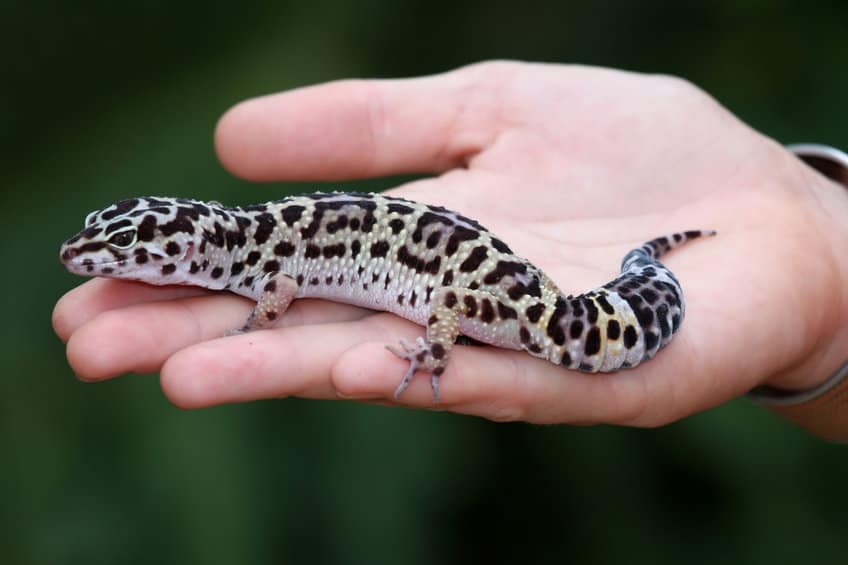
Leopard Geckos, with their huge eyes and seemingly smiling face, are the perfect intro reptile because of their hardy nature. They are small (up to 8 inches) and only need a 20-gallon tank with minimal maintenance which makes them great for kids. They live for a good 10-20 years if properly cared for and need the usual UVB lighting, heat source (heat pad recommended for belly heat), and a few hiding places in their enclosure. Leopard Geckos are white or yellow with dark spots and are known to be vocal especially when hungry or seeking attention.
Bearded Dragons
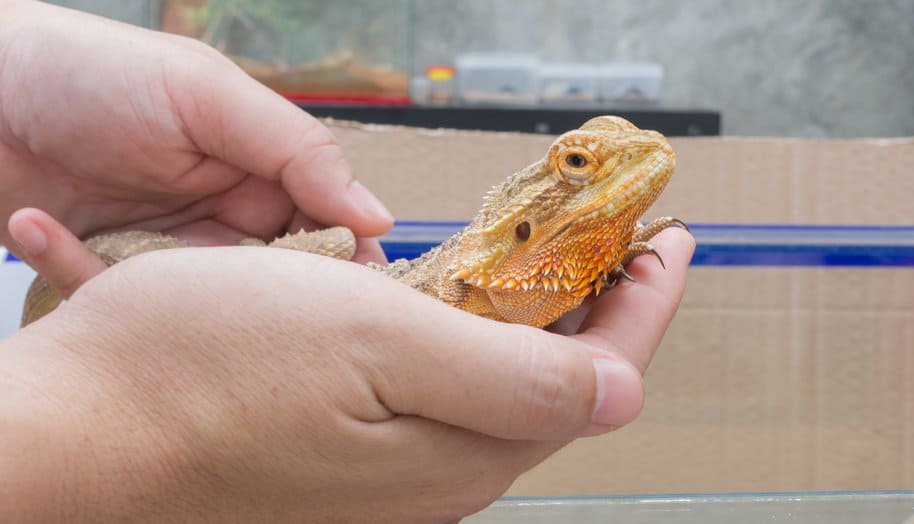
Bearded dragons are a crowd favorite. They generally have a calm temperament and are known for their unique looks. They’re a bit more challenging than the rest of beginner-friendly reptiles because of the money and equipment involved in caring for them. They do need big enclosures (50 gallon recommended) and specific lighting equipment (UVB and heat lamp). They live to be about 10-15 years and can be good pets for children with proper handling.
Ball Pythons
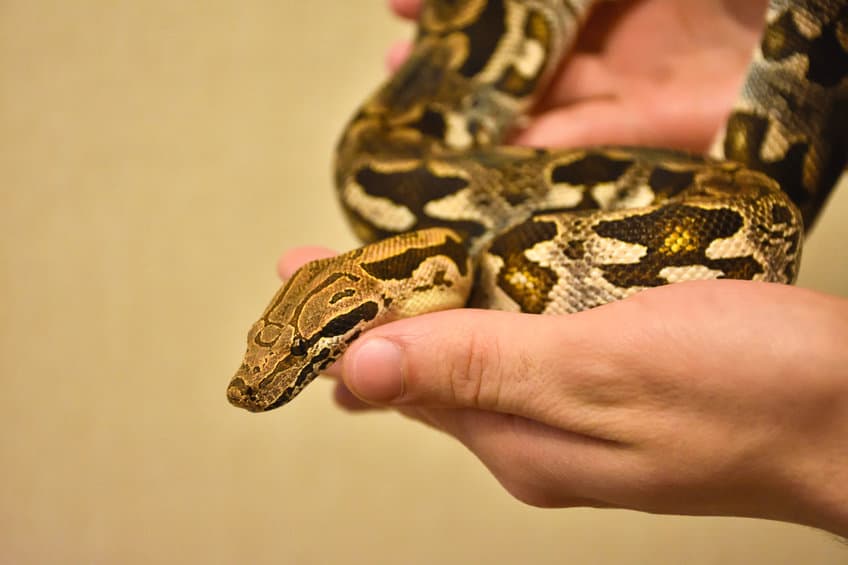
Ball pythons require simple care except for being a bit picky with their food. This can easily be remedied by asking tips from a responsible breeder and sticking to a good feeding schedule early on. Ball pythons are easy to care for; requiring a 40-gallon tank as adults, a heat pad, infrared light, and the humidity at 55-60% RH. They should also have some hiding places in their tank for their comfort. They grow up to 5 feet and can live up to 30 years!
Corn Snakes
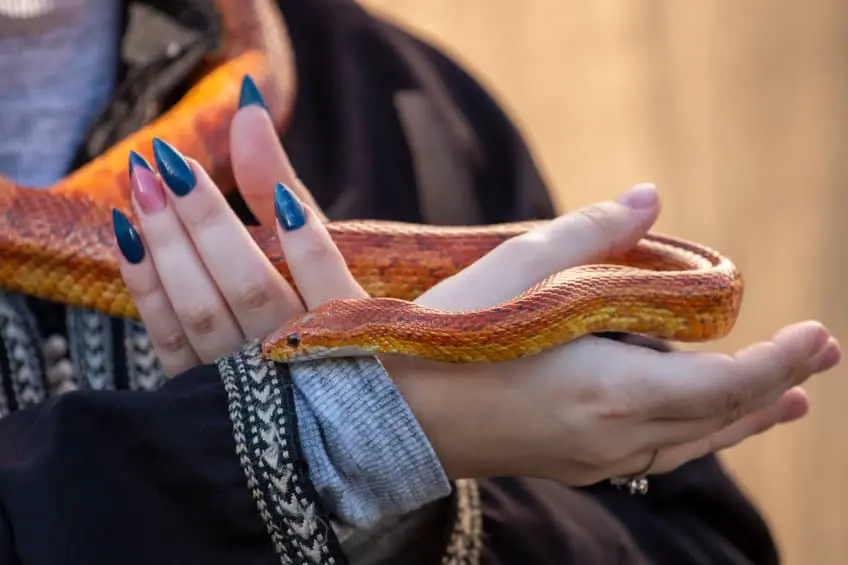
Corn snakes are docile and easy to care for. You just need a secure enclosure with a very tight lid since they can be quite the escape artists. They grow up to be about 3-5 feet long and live up to 10 years. These bright orange to red snakes are beautiful and can be a great ESA.
The main challenge with snakes such as ball pythons and corn snakes would be feeding them live feed (rodents such as mice) which may be hard for a lot of people. It can be tricky but they really only need to be fed once a week, maybe even less and can be left on their own for a few days, making them a good choice as emotional support animals.
Eastern Box Turtle

Eastern Box Turtles are land turtles that do not need the same aquatic requirements that make Red Eared Sliders challenging to care for. This makes them the perfect choice for those who would want a turtle as their ESA. They grow between 5-7 inches long and can live up to 30-40 years in captivity. A 40-gallon tank will do well for adults but bigger is also better. They don’t need water in their enclosures but do need a more humid environment (70% RH) in addition to the basic reptile care.
Reasons Why Reptiles MAY NOT Make Great ESAs
Though reptiles are great emotional support animals, there are a few reasons why they may not be the best choice.
There are some reptiles who do not enjoy being handled (like chameleons, for instance) so if you want to be able to bond with your ESA in that way then a reptile may not be for you.
They might also be a bit harder to bring in public (especially in plane cabins) since some people may be scared of reptiles because of certain negative perceptions of them (e.g. they may be venomous).
Also, certain establishments may not readily accept them even with an ESA license especially if the welfare of the general public is at stake. In addition to that, big reptiles (e.g. big snakes) may not be allowed in most forms of transportation (especially planes).
Lastly, certain reptiles require detailed husbandry so if proper care becomes too challenging, it may also become a source of anxiety for the owner. For example, chameleons who dislike being handled and are mostly for advanced reptile keepers, may not make great ESAs.
Do All Reptiles Qualify To Be An ESA?
Technically, yes. Any household or domesticated pet with an ESA letter can qualify as an emotional support animal. This includes reptiles, even snakes. The only caveat to having a reptile as an ESA is the mixed public perception of these beautiful creatures. Some may be afraid of reptiles, especially snakes.
How To Register An ESA
- Register with an Emotional Support Animal organization.
There are many organizations but the most popular one is Emotional Support Animal Registration of America (ESARA). Registration is usually done online and will require you to input some basic information as well as a photograph of your animal.
Take note that registration online alone DOES NOT make your animal an ESA. Additional official documentation is required for your ESA to be recognized especially for travel.
- Consult with a licensed medical professional about obtaining an Emotional Support Animal.
Check with a licensed medical professional accredited by the ESA Registration of America (ESARA) for a consultation about adding an emotional support animal to your treatment or registering your current pet as an ESA. This consultation will allow you to ask questions about ESAs, clarify anything you need, and help you obtain proper documentation for your animal.
- Secure a written certification or an ESA Evaluation Letter.
Secure a written certification from your physician indicating that your animal is required for your emotional needs. This letter should contain the following useful information below. This document is updated yearly and is required when you bring your ESA in public places.
- Diagnosis of your condition (if applicable)
- Treatment involving your emotional support animal
- Name, license number, and contact details of your physician
The ESA organization you registered with can help you with your ESA Evaluation Letter or official documentation from a licensed physician.
- Obtain an ID or ID vest, harness, and portable carrier for your ESA.
Identification for your ESA is quite useful especially if you plan to take it into public areas. For reptiles, ID vests are available as well. Consider getting a harness as well as a portable carrier for your reptile so there’s no hassle when you take it with you.
This ID, along with the official documentation of your ESA may be required by landlords, apartments, before boarding transportation, or in public places.
- Pay for the registration fee.
There are different types of registration packages depending on the organization but the minimum should include documentation, identification for your pet, and registration onto the ESA database. The prices range from $30-$150 USD.
A note on responsible ESA ownership and registration
There have been numerous instances of animals (not just reptiles) being registered as emotional support animals just as an excuse for their owners to bring them on board planes, different places, or in “no-pet policy” housing legally without much consequence or fees (under the “Disabilities Act” and/or “Fair Housing Act”).
While mental health should definitely be a priority, please do not abuse the ownership or registration of an emotional support animal for the benefit of those who really need them.
Please also try to consider “communal well-being” when you bring your ESA to a public place. For example, a lot of people are afraid of snakes, so please exercise caution and responsibility when bringing them to crowded public areas.
If you plan on traveling with your ESA, it’s still best to do research if they will eventually be allowed on board a plane (or a bus, train, etc.) even with an ESA license secured, just to be sure and to avoid a potentially stressful situation for you and your reptile. Different airlines may have different rules.
ESA ownership for the benefit of yourself and your animal
Emotional support for mental well-being from any source, be it animal or otherwise, is definitely a big step towards healing. Reptiles can be effective emotional support animals but we recommend working very closely with your mental health professional or therapist about the correct emotional support animal for you. To ensure that both your and your animal’s welfare are kept in mind.
Reptiles can be relatively easier to care for (and definitely need less attention) compared with most common ESAs like cats or dogs, but they do require some specific points for their proper care. For example, specific temperature and humidity levels will need to be met in their enclosure at all times.
Talk with your therapist closely about including a reptile into your treatment. For example, if you and your therapist expect that you’ll be needing the reptile in situations that could also stress out the animal, then you may want to reconsider. For example, if you will be traveling on the plane often, then it can lead to chronic stress to your reptile as well.
How Much Does ESA Registration Cost?
Registration (complete with documentation) usually ranges from 30 to 150 USD depending on the inclusions the ESA organization offers. Some packages include IDs, a pet harness, and a guidebook but the minimum inclusion is registration in the database, official documentation, and an ID.
Conclusion
Reptiles can make great emotional support animals and have the extra advantage of being unique and relatively easier to care for than the usual cat or dog. They offer the same benefits all ESAs offer, allowing their owners to be happier, less anxious, and more focused because of their care needs.
FAQs
Can snakes be emotional support animals?
Yes. Certain snakes, with their docile temperament, can be a source of calm for some people. Any domesticated animal or house pet can be registered as an emotional support animal with no additional training required.
Can a reptile be an ESA?
Yes. Any domesticated animal or house pet can be registered as an emotional support animal, including reptiles, with no additional training required. Reptiles as ESAs have a lot of advantages. They are relatively smaller and easier to handle. They require less attention and are often hypoallergenic.
References
Overview on Emotional Support Animals
Emotional support animal – Wikipedia
FAQs on Emotional Support Animals
FAQs on Emotional Support Animals
Article on Emotional Support Animals
Confirming the benefits of emotional support animals – Counseling Today
Different ESA Registration Sites:


